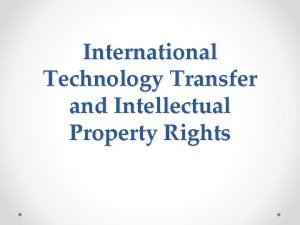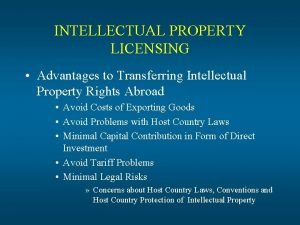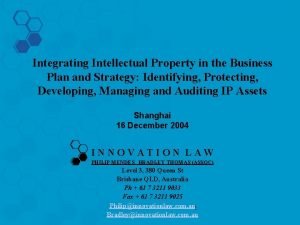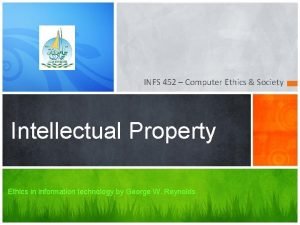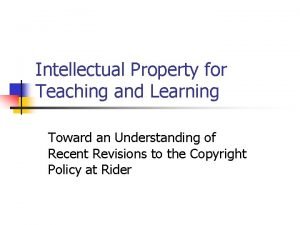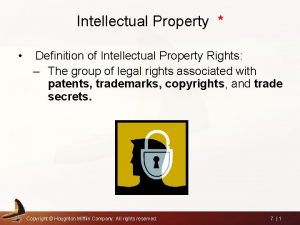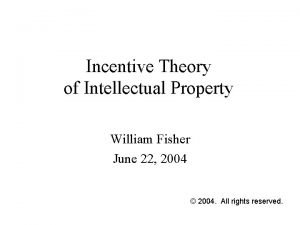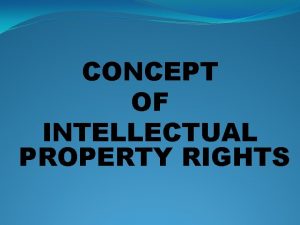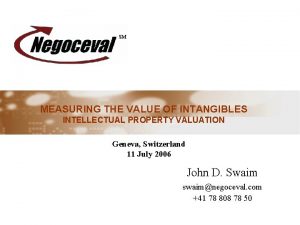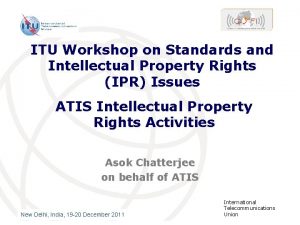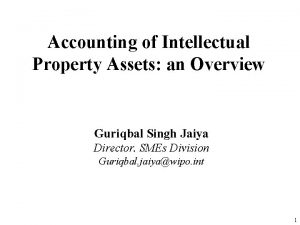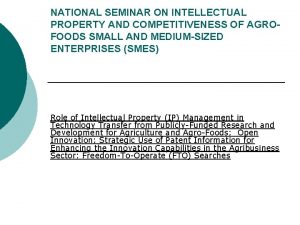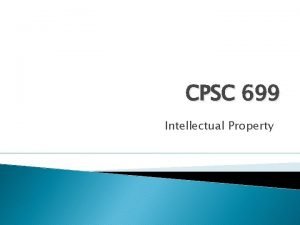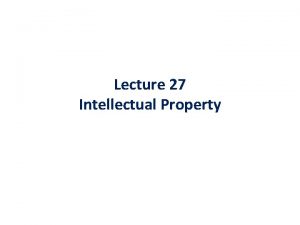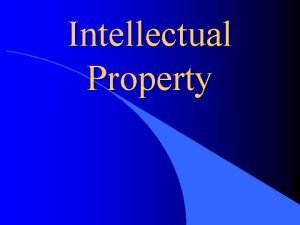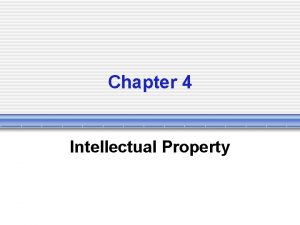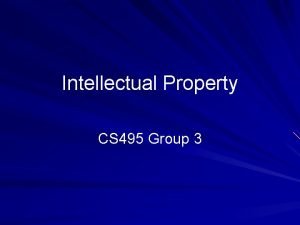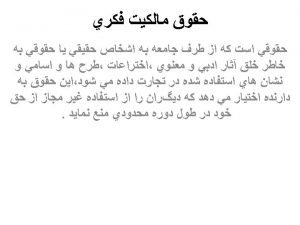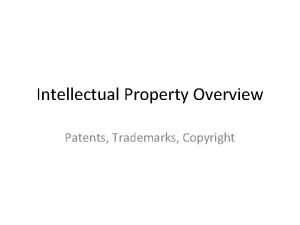INTELLECTUAL PROPERTY MANAGEMENT Create intellectual property Define research


















- Slides: 18

INTELLECTUAL PROPERTY MANAGEMENT • Create intellectual property – Define research strategy • Manage intellectual assets – Sell/acquire – Add value – Generate wealth

INTELLECTUAL PROPERTY OR ASSETS • Patents • Trademarks / Designs • Copyrights Intellectual property of assets management • Formal techniques for accurately measuring and managing the potential of intellectual property or assets within an organization for creating future value • In a sense, it is an accounting system, based in intangibles such as knowledge of workers, current R&D efforts, patent portfolio, in-house knowledge, both documented and resident in people

INTELLECTUAL PROPERTY Industrial property - Patents - Designs - Trademarks Copyright - Literary – artistic works - Electronic media - Performances of artists

WHAT IS A PATENT • A right granted to inventors to prevent unauthorized use of an invention, within a particular territory, for a limited time • Does not guarantee the inventor the freedom to exploit his invention restricted by : Earlier patents : External factors • A patent allows an invention to be developed / exploited by the inventor while others are kept out (exclusive) patents are public disclosure the state grants limited monopoly rights to inventors in exchange for full disclosure • A patent is a scientific / leage document • A patent is a negative monopoly

REQUIREMENTS OF PATENTABILITY Substantive requirements • Subject matter : 101 • Utility : 101 • Novelty : 102 • Obviousness : 103 Procedural requirements • Enablement • Definiteness : 112 • Best mode Ideas /Concept cannot be patented

BODY OF PATENT “Subject” “Prior art” Statement of the “problem” “Objects” of the invention (benefit) “Definition” of the invention Elaboration of the invention Description of “utility” Working examples “Claims” or legal description of exclusive rights ------------Background of the invention Summary of the invention Description of specific embodiments Examples Claims

SUBJECT MATTER • Manufacture • Machine • Composition of matter • Process e. g. Genetically modified bacteria human engineered mice • Utility Minimum demonstration • Novelty Not anticipated in “prior art”- anything previously published, patented, known, used, sold, publications by inventors more than one year before filing patent application

SUBJECT MATTER • Obviousness Knowledge at the time of invention must not be obvious to one of ordinary skill in that area determined by – Scope / Content of prior art – As level of ordinary skill in technology increases, so does the obviousness of advances • Enablement

HOW TO WRITE THE PATENT APPLICATION 1. Think : What is the inventive step How your method is different from the way other people do it. Characterize the invention at the most abstract level 2. Has anybody else done it before? 3. Writing the text : Structure • Introduction Area of application Problem the invention addresses • Prior art How do other do it what is wrong or inadequate with what they do Cost, complexity, difficulty of manufacture

HOW TO WRITE THE PATENT APPLICATION • • Description of invention – The inventive step – What is right or better about what we propose – Examples of implementation Writing the text : Wording – Scientific accuracy – Precision in language – Legal veracity – Others cannot get around it Ability to use the invention without “undue experimentation” (specification)

HOW TO WRITE THE PATENT APPLICATION – Definiteness inquiry Understanding limits of invention based on claim language Best mode Best way known to him/her to carry out the claimed invention Disclosure must allow a person of “ordinary skill in the art” to practice the invention Concealment of best mode results in projection

R&D ALERTS FOR PATENT PROTECTION • Record the date of conception of an idea • Record the date when the conception was first “reduced to practice” • Show “due diligence” in reducing the invention to practice • Sign and witness all entries in notebook. The laboratory notebook is a legal record. A system for lab record keeping should be evolved

WHO CAN QUALIFY AS INVENTORS • Provider of the idea / concept • Members of team who made significant conceptual contributions • Every team member should have his own notebook or document to record his contribution, dated, signed and witnessed • If you design an experiment for someone else to perform enter your instructions into your notebook

FACTORS TO CONSIDER IN DECIDING TO FILE • • Nature of invention Fit with business interest Economic value of the invention Other patents that might limit the freedom to exploit (dominating patents) • Patent confers the right to exclude others from practicing the invention, not a right to use it • Is it for offensive or defensive purpose? • Are there other patents in the field held by same inventors? Decision to file Business decision Economic incentive

PATENT ACTIVITY TRACKING ……. • Enables identification of institutions that are loci of inventive activity • Provides a measure of productivity of an organization’s S&T human resource • Share of foreign patenting by domestic inventors highlights a nation’s attractiveness as a market for new technologies

DECISION TO PATENT – HOW? 1. 2. 3. 4. Record conception of idea Record reduction to practice First experimental demonstration Decide to patent 1. Nature of invention 2. When was it made 3. Where is it recorded 4. Has it been disclosed publicly 5. Nature of prior 6. How complete are the data Prepare an invention disclosure 1. Names of inventors 2. Date of conception 3. Date of reduction to practice 4. Brief description 5. Justification for novelty 6. Application / use

BRINGING THE IDEA TO THE MARKET Idea Invention Patent Application Examination, Assessment and Evaluation of Invention Scope in the market Grant of Patent protection Promotion of Ideas Review Market Licencing / Joint Venture Production of Prototype Test Marketing Product Launch Sales Rewards

PATENTS : HIDDEN BENEFITS • • • Advantage of technology Source of information Economic indicators (R&D investment) Innovation indicators Delineation of technology fronts (useful for technology forecasts)
 Intellectual property management definition
Intellectual property management definition Apa itu mutiple queue dan one way list
Apa itu mutiple queue dan one way list Trade-related aspects of intellectual property rights
Trade-related aspects of intellectual property rights Secondary infringement
Secondary infringement Importance of intellectual property
Importance of intellectual property Advantages of intellectual property
Advantages of intellectual property Intellectual property in business plan
Intellectual property in business plan Property
Property Right to intellectual property of teachers
Right to intellectual property of teachers Industrial property definition
Industrial property definition Theories of intellectual property william fisher
Theories of intellectual property william fisher Concept of intellectual property
Concept of intellectual property Valuing intangible assets
Valuing intangible assets Intellectual property rights
Intellectual property rights Intellectual property rights
Intellectual property rights Characteristics of intellectual property
Characteristics of intellectual property Discuss intellectual property frankly
Discuss intellectual property frankly Sfas 142
Sfas 142 Intellectual property
Intellectual property




